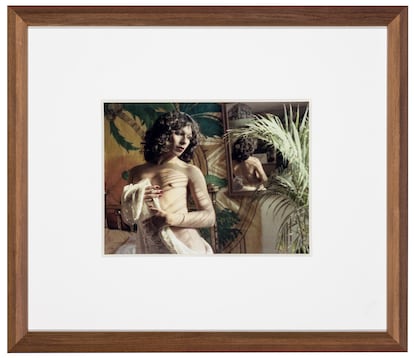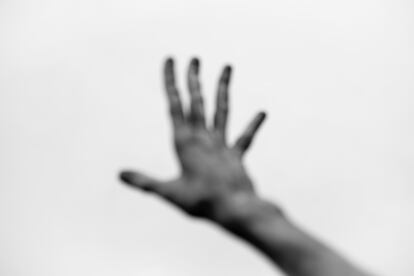The renovated Grand Palais has once again become an essential meeting place for the photography community these days, with the celebration of Paris Photo, the main photography fair in the world. An event that increasingly welcomes views from different parts of the world, while offering a dialogue between historical works and more contemporary perspectives, expanding the horizons of photography and fostering a dynamic conversation about the present and the future. of the middle.
In the central part of the nave, a surprising installation made up of a 36.5 meter long wall welcomed visitors. It housed the entirety of the famous and utopian project undertaken by August Sander (1876-1964), from 1920 until his death: Man of the 20th century, whose influence continues in the following generations. 619 portraits, through which the German photographer set out to create an archive of humanity in the 20th century. A cross section of German culture observed under the neutral gaze of one of the great masters of 20th century photography, in which all social classes and professional groups of their time had a place, presented in its entirety for the first time in Europe by Julian Sander Gallery.
Likewise, the Gagosian Gallery offered an attractive reflection on portraiture and its function in the construction of identity through Avedon & Me; establishing a dialogue between some of the most iconic photographs taken by Richard Avedon (1923-2004)—such as the challenging portrait of the women of the conservative convention of the Daughters of the American Revolution, or that of Marian Anderson, the first black opera singer — and the powerful profiles of Tyler Mitchell (1965), the first African-American artist to sign a cover for the magazine Vogue. The centenary of Robert Frank (1924-2019) did not go unnoticed at the fair. Thus, the Zander gallery showed a selection of the most experimental works by the author of The Americans. Intense and emotional images, made between the seventies and nineties, with a biographical background, to which the Swiss artist incorporated words, giving shape to a unique aesthetic in photography. Heartbreaking and personal, they address themes as intimate as they are universal.
The compelling works that were exhibited in the Higher Pictures gallery also come from the last decades of the 20th century. As Grapevine, Susan Lipper’s iconic series (1995), a subtle exercise in collaborative documentaryism, exhibited alongside the self-portraits of the photographer, activist and writer Carla Williams (1965), and Janice Guy (1953), who challenge traditional notions of the self-portrait and of the role of the photographer, alongside Folded Papers, Sheila Pinkel’s experimental series (1941), in which she explores light as an artistic material, creating a “space-time paradox,” by capturing three-dimensional forms in two-dimensional photographs.
The photosculptures of Anglaia Konrad (1960), exhibited in the Belgian gallery Nadja Vilenne, are part of this experimental trend in the photographic medium, clearly highlighted in this latest edition of the fair. The Austrian artist defines herself as an architect of photography, creating exhibition systems in which images interact with the specific spaces, contexts and situations in which they are shown, thus renewing the field of architectural photography and its presentation.

Also highlighted in these days are the sculptural installations by the South African Lebohang Kganye (1990) exhibited by the La Patinoire Royale Bach gallery, within the sector Voices. It is the first time that Paris Photo invites three international curators to present proposals with new voices from different places that are not usually represented at the fair, such as Africa, Latin America and Lithuania. “An important initiative that helps make visible the work of these artists and these galleries that, working in collaboration, make exhibiting at a fair like this much more viable. Something very stimulating for them,” highlighted Elena Navarro, commissioner of imperfect paradises, within which the Madrid gallery Memoria has presented part of the powerful series by the Chilean Paz Errázuriz (1944), bodies, along with the work that Maya Goded (1970) dedicated to prostitutes in central Mexico from a feminine and activist perspective, as well as that of the multidisciplinary artist and trans rights activist, Terry Holiday (1955), and that of the Mexican Yolanda Andrade (1950).
Within this sector, and in collaboration with the Mexican gallery RGR, tribute was paid to Manuel Álvarez Bravo (1902-2002), as part of the commemoration of the centenary of surrealism, to which the fair has joined. The six images that make up the making of of the iconic The good reputation sleeping, made in 1939 as a commission by André Breton for the cover of the catalog of the International Exhibition of Surrealism, held in Mexico in 1940. The image was never used, discarded for being erotic. Carmen Calvo (1950) and Dario Villalba (1939-2018) spoke about the use of photography in art through the unique pieces presented by the Valencian gallery Luis Adelantado, where the collage It is combined with pictorial gestures. It should be noted that She has been found (2003), by Calvo, was part of the surrealist tour curated by American director and screenwriter Jim Jarmusch, as well as the Elles X Paris Photo tour, curated by Raphaëlle Stopin. “For artists to leave our environment is very complicated, it requires an effort for both the gallery and us,” warns Calvo.

The presence of Spain has increased significantly in this edition: eight galleries are present and one publishing house, RM, within the space dedicated to books, out of a total of 240 exhibitors from 34 countries. Within the Emergence sector, curated by Anna Planas, artistic director of the fair, you could see the work of the Basque artist Jon Gorospe (1986), represented by Dark Camera, that revolves around the entropic landscape, as well as that of Miguel Ángel Tornero (1978), who presented an installation on site from the series Altamira, inside the Juan Silió gallery. In the main sector, the silent landscapes of Bleda and Rosa shared space with the work of Nil Yalter (1938), Golden Lion for his artistic career at the last Venice Biennale. Highlighted The Macondo Archive (the zero time curve), by the artist François Bucher (1972), composed of 26,454 photographs of anonymous people taken in Bogotá, in the stand by Alarcón Criado.

The most corrosive work of Carlos Aires (1974) shone in ADN, as did Lúa Ribeira (1986) and Toni Amengual (1980) within RocioSantaCruz. “Spain continues to be a country of historical and contemporary photographers, but their presence is very limited. They are known more thanks to the galleries than to any institutional work,” the gallery owner complains. “There is a lack of understanding that the cultural industry can be very beneficial for everyone. With what we have we make miracles,” adds Amengual. “Interestingly, many times recognition comes more internationally than nationally, but it often wears out quickly, because there is no continuity of support from your own country and the journey ends,” says the Magnum photographer.
The Alta Gallery, based in Andorra, presented a compelling selection from the Ramón Masats archive, where many unpublished images of this great master of Spanish photography could be seen. Despite his vast career, he never considered himself an artist. France Info presented him as “the unknown Spanish Cartier-Bresson”, underscoring his unique ability to capture the everyday with a deep and timeless gaze.
